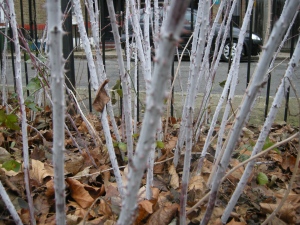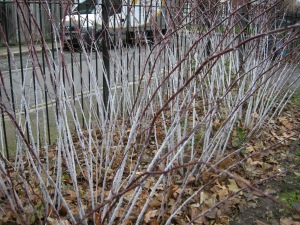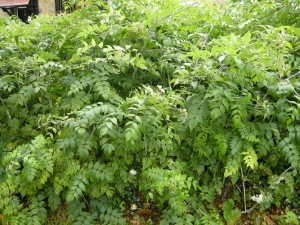Position: Full sun to dappled shade
Soil: Moist, well drained
Flowering period: Early summer
Eventual Height: 2.5m
Eventual Spread: 2.5m
Hardiness: 5a, 5b, 6a, 6b, 7a, 7b, 8a, 8b, 9a, 9b
Family: Rosaceae
Rubus cockburnianus is a deciduous shrub with attractive winter stems and an arching habit. The bright green leaves are imparipinnate, containing up to 9 leaflets. Its leaflets are ovate to lanceolate, with serrate margins, up to 10cm long and 4cm broad. Its biennial stems are arching, may achieve a length of up to 3m and turn white during the winter months. Its pink flowers are saucer shaped, up to 1cm across and appear in the leaf axils on second year wood. These are followed by small unpalatable purple/ black fruits which are up to 1cm across.
Rubus cockburnianus, commonly known as the White Stemmed Bramble, is native to south China. It was introduced to the botanical community by E H Wilson, in 1907. In its native habitat it grows in forests, thickets and riverbanks.
The etymological root of the binomial name Rubus is derived from the old Roman name for this plant. Cockburnianus may named be after the Cockburn family but the pronunciation of “coburnianus” leaves this in doubt.
The landscape architect may find Rubus cockburnianus useful as an impenetrable barrier plant, possibly in the form of an informal hedge, which provides attractive white stemmed interest during the winter months.
Ecologically, Rubus cockburnianus provides food a variety of insects, mammals and birds. Caterpillars will feed on it’s leaves, some mammals will graze on its leaves and birds will feed on its fruit. This plant also provides valuable cover for nesting birds.
The Royal Horticultural Society have given Rubus cockburnianus their prestigious Award of Garden Merit.
Rubus cockburnianus prefers moist, humus rich, well-drained soils. It tolerates most pH of soil. It will not tolerate waterlogged soils.
Rubus cockburnianus should be pruned as if they were autumn-fruiting raspberries, by cutting the old canes close to the base in late winter or early spring, and make space for the new ones growing up. This will sacrifice flowers and fruit, but the flowers are insignificant and the fruit is not worth harvesting. This plant is grown for its winter interest and since the colour is best on very young canes and, moreover, abrasion of one stem on another tends to remove the waxy bloom, this method ensures the whitest stems in winter.







Leave a comment